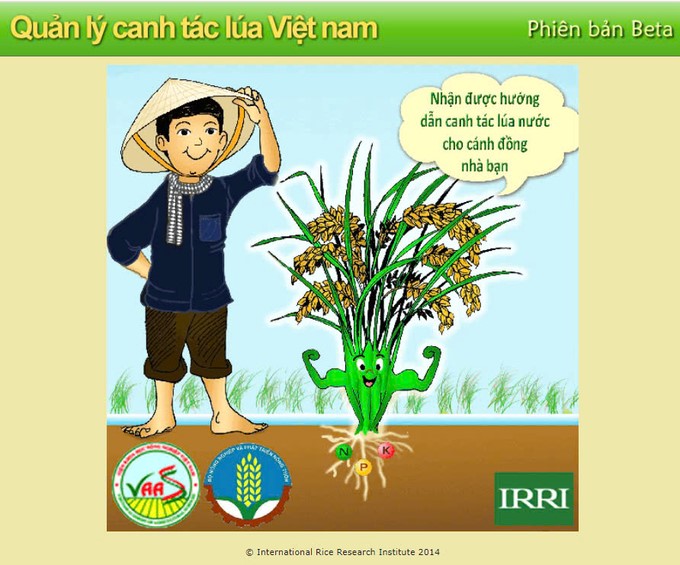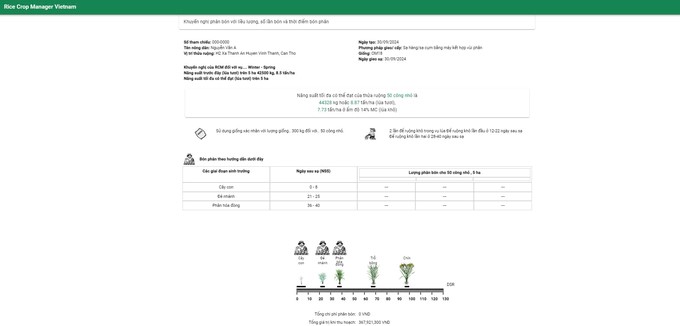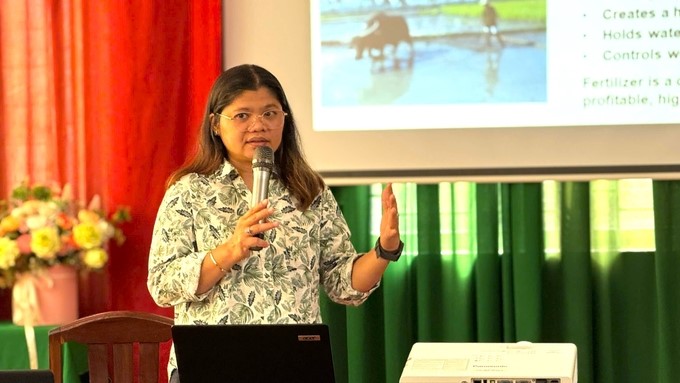June 20, 2025 | 20:43 GMT +7
June 20, 2025 | 20:43 GMT +7
Hotline: 0913.378.918
June 20, 2025 | 20:43 GMT +7
Hotline: 0913.378.918
Within the framework of the Fertilizer Right Project (FerRight) that is chaired and sponsored by the Foreign Agricultural Service (FAS) of the U.S. Department of Agriculture (USDA), on September 30, the Can Tho City Sub-Department of Crop Production and Plant Protection coordinated with the International Rice Research Institute (IRRI) to organize an assessment of user acceptance of the "Crop Nutrient Management" application (referred to as the RCM application).

The interface of the RCM application that helps farmers manage crop nutrients effectively. Photo: Kim Anh.
The pilot development of the RCM application is one of the activities to launch the Fertilizer Right Project in Vietnam, with the goal of receiving feedback from users. From there, the development team will improve the application, ensuring it is suitable for the practical farming conditions of each locality.
Ms. Tran Thi Kim Thuy, Deputy Director of the Can Tho City Sub-Department of Crop Production and Plant Protection, said that the RCM application will help farmers access technical advances and test field reality accurately.
Based on farmers' input data such as field area, yield target, sowing method, rice variety used for sowing, fertilizer type, etc., the RCM application will provide recommendations on fertilizer dosage, fertilizer source, time of fertilization, and water management.
At the same time, the application also calculates the cost of fertilizer investment for each specific field based on the needs of the crop according to the maximum yield that can be achieved on each different land area.

The RCM application has the function of providing recommendations on fertilizer dosage, fertilizer source, appropriate time of fertilization, water management, etc. Photo: Kim Anh.
To evaluate the effectiveness of the application, it is expected that in the winter-spring crop of 2024-2025 and summer-autumn of 2025, the Can Tho City Sub-Department of Crop Production and Plant Protection will select 24 farmer households in three key rice-growing localities., including Vinh Thanh, Co Do, and Thoi Lai, to build pilot models. Each model has a scale of 1,050 m2, with three independent farming variables: 500 m2 cultivated according to traditional practices; 500 m2 of cultivation as recommended by the RCM application; 500 m2 cultivated according to the RCM application's recommendations but without nitrogen fertilization.
Ms. Rowena Castillo, IRRI's project management and development expert, said that the RCM application will be run on the website platform at the address: https://webapps.irri.org/vn/rcm-rebuild/.
User reviews and feedback on advantages and disadvantages of the RCM application are very essential for the application to be the most effective when officially launched.

IRRI's expert introduces the RCM application. Photo: Kim Anh.
Previously, in April 2024, the Ministry of Agriculture and Rural Development, in collaboration with the U.S. Department of Agriculture, launched the Fertilizer Right Project in Vietnam with the Plant Protection Department (Ministry of Agriculture and Rural Development) as the project owner and the International Rice Research Institute (IRRI) as the implementing unit.
The project is implemented in three Red River Delta provinces, namely Hai Duong, Thai Binh, and Nam Dinh, and in three provinces and cities in the Mekong Delta, including Dong Thap, Soc Trang, and Can Tho City. The project includes three components. Specifically, component 1 is developing technology and tools to use fertilizer effectively in rice growing. Component 2 will improve communication capacity for stakeholders on correct fertilization practices for rice plants. And component 3 is to monitor and evaluate project implementation.
It is expected that over a period of 4 years (2024-2027), with an estimated budget of USD 4.4 million, the Fertilizer Right Project will support farmers in the above-mentioned localities to access advanced techniques and technology and precision agricultural practices. From there, use inputs optimally, especially fertilizers, to improve efficiency and effectiveness of fertilizer use, increase income, and reduce greenhouse gas emissions.
Translated by Thu Huyen
![Turning wind and rain into action: [9] Digitizing hydrometeorological data in response to climate change](https://t.ex-cdn.com/nongnghiepmoitruong.vn/608w/files/news/2025/06/17/z6704423696987_15fd32ffc26d590d204d520c9dac6786-nongnghiep-165943.jpg)
(VAN) Farmers have begun accessing hydrometeorological applications to adjust their cropping schedules, aiming to ensure productivity and adapt to climate change.
![Turning wind and rain into action: [8] Real-time salinity detection and early warning technology](https://t.ex-cdn.com/nongnghiepmoitruong.vn/608w/files/news/2025/06/17/z6704423696987_15fd32ffc26d590d204d520c9dac6786-nongnghiep-151127.jpg)
(VAN) Thanks to the integration of modern hydrological-hydraulic models, remote sensing technologies, and artificial intelligence, the accuracy of hydrological forecasting has significantly improved.
![Turning wind and rain into action: [7] Early disaster warnings help marine farmers minimize losses](https://t.ex-cdn.com/nongnghiepmoitruong.vn/608w/files/news/2025/06/17/z6704423696987_15fd32ffc26d590d204d520c9dac6786-nongnghiep-142942.jpg)
(VAN) In recent years, thanks to early disaster warnings and forecasting, marine farmers in Khanh Hoa province have been able to reduce risks and losses, thereby improving production efficiency.
![Turning wind and rain into action: [6] ‘Four on-the-spot’ disaster management software](https://t.ex-cdn.com/nongnghiepmoitruong.vn/608w/files/news/2025/06/17/e5a48259d6a262fc3bb3-nongnghiep-183800.jpg)
(VAN) By simply activating the scenario on the disaster management software, the relevant authorities immediately know how many households need to be evacuated, where to evacuate them to, and by what means of transportation…
![Turning wind and rain into action: [5] Hue applies modern technology in disaster forecasting](https://t.ex-cdn.com/nongnghiepmoitruong.vn/608w/files/news/2025/06/17/z6704423696987_15fd32ffc26d590d204d520c9dac6786-nongnghiep-093938.jpg)
(VAN) In Hue city, modern technology has recently been applied in meteorological and hydrological forecasting and warning, helping to reduce the damage caused by natural disasters.

(VAN) A cutting-edge farming technique being implemented on an experimental ranch in Arizona's Sonoran Desert has already saved a billion gallons of water over five years, according to Civil Eats.

(VAN) Poultry and pig production and the environment can be boosted through enhanced water technology, according to new research.